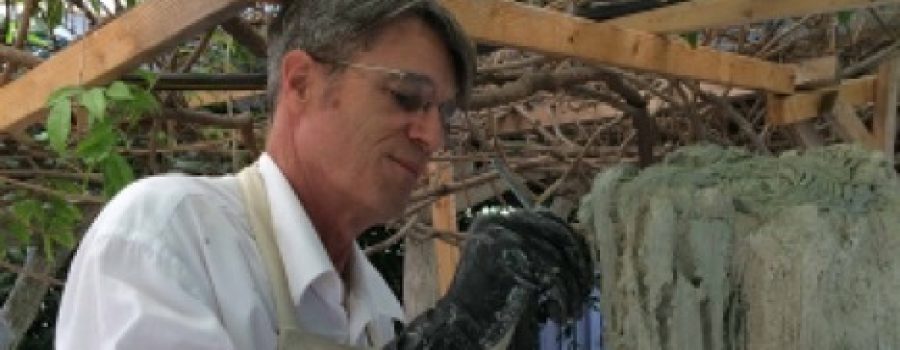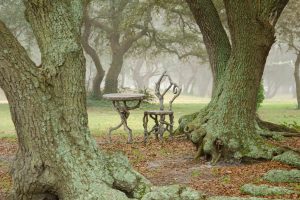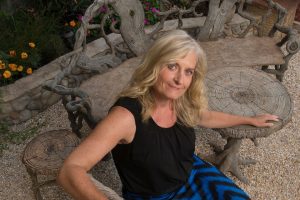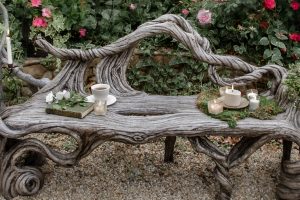Few people are more passionate about faux bois than Terry Eagan. He has restored the oldest known collection of concrete faux bois in the United States, built on the grounds of The Huntington Library, Art Collections and Botanical Gardens (or, The Huntington) in San Marino, California.
Restoring century-old faux bois is a fitting pursuit for a someone with a background as a muralist, sign painter, scenic artist, and faux and decorative finish specialist, especially if he has a heart for restoring historic buildings and landmarks to their former glory.
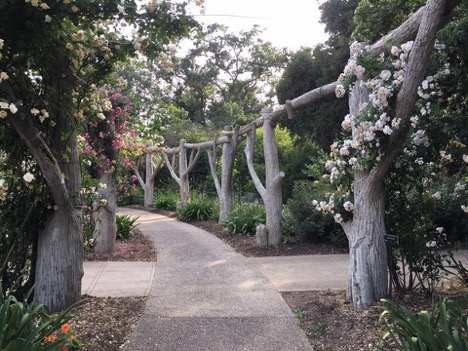
Faux bois arbors restored to their former glory at The Huntington’s Rose Garden
Nearly 20 years ago, when Terry visited the 120-acre estate of Henry and Arabella Huntington (now The Huntington), he was saddened that the 100 faux bois trees, as well as beams and handrails in the Rose and Japanese Gardens, had fallen into ruin. As fortune would have it, the garden staff was looking for someone to repair them, and Terry landed the largest restoration project of his career.
Willing to take on a new challenge, Terry taught himself how to restore the faux bois structures. Nearly every day for more than seven years, he has been joyfully rebuilding trees and talking to visitors about this little-known art form.
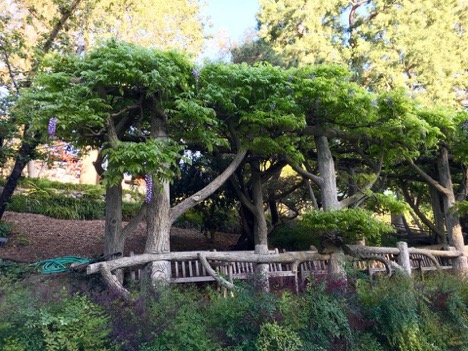
The beautiful faux bois trees at The Huntington are preserved for future generations.
Diane Husson: What are your greatest challenges working with concrete outside?
Terry Eagan: Containing my mess in a world class garden without moving or disturbing plants that are inside my work space, sometimes directly under and intertwined with the sculpture! There is a lot of draping with canvas drops, etc. to avoid chaos and spatters.

Terry, getting ready to fill a new faux bois beam with concrete mix.
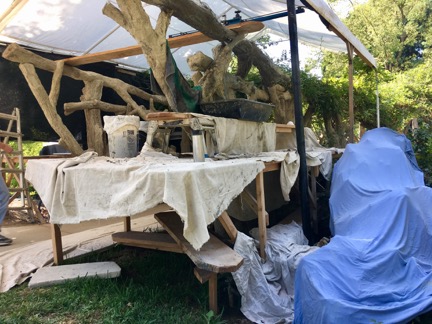
Terry’s work area is draped like a surgical field to protect nearby plants.
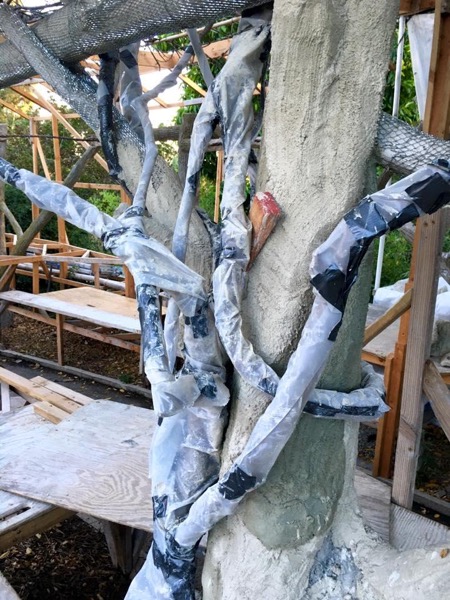
The wisteria vines get wrapped in plastic to protect them while the sculpting mix of grout is applied.
DH: Are you restoring the structure according to geographic sections, or by the priority of greatest need?
TE: Geographically, section by section, defined by what fits under my tent.
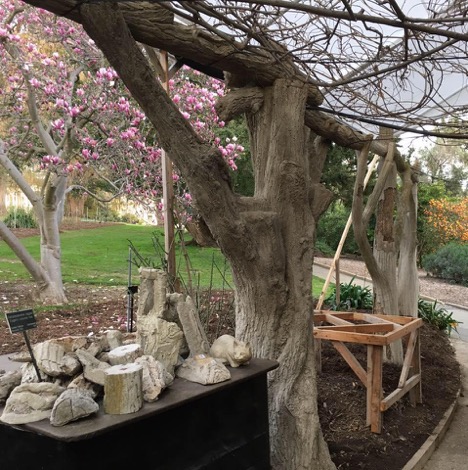
Broken pieces of concrete from the original faux bois trees are displayed to educate visitors about early faux bois methods and materials.
DH: How many months a year are you able to work outside?
TE: In Southern California I can work all the time, rain or shine, hot or cold. I prefer the winter because it never gets too cold. For Summer I’ve developed techniques to slow the mix in hot weather. I build a temporary tent structure over my work area for rain and shade. I build my own scaffolding with lumber that is easy to change, rearrange and reuse.

Terry works under a tent rain or shine, with moveable wooden scaffolding.
DH: What was your learning curve when you were figuring out how to restore old faux bois?
TE: The craft, the way it was practiced decades ago, was not very sophisticated. To restore it, I needed to apply my understanding of how reinforced concrete works and what causes the decay. This meant learning why the metal will rust in some places and not others. How do I arrest the rust? Addressing that, I could be sure that my repairs would hold and the efforts would not be a hopeless pursuit fixing something that would continue to decay.
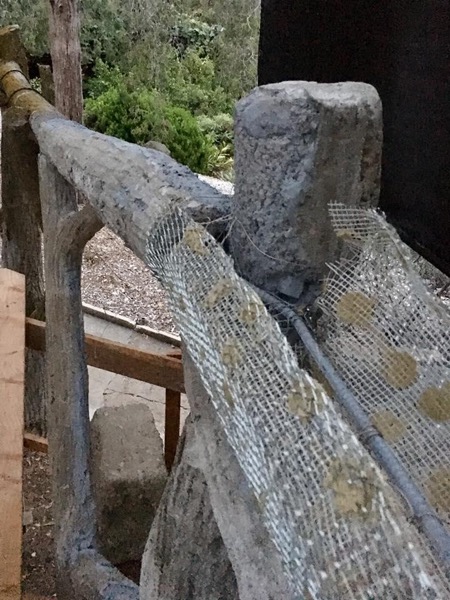
Rebar, fiberglass mesh and lath are prepped, soon to be filled with concrete.
DH: What does a thorough restoration involve?
TE: Critically, it would be learning new techniques through trial and error to make my work match and blend with the existing old sound material. I am blending the appearance of the new work to the old. I’m a team member, finishing what they started a century later. Now, understanding what made it fail, I can repair and correct it. I’m saving the sculpture from the first 100 years for a long future.
DH: Have you come across any documentation that would shed some light on who these artisans were?
TE: Unfortunately we don’t know their names or where they came from. So far, I have not found any other faux bois installations in America older than The Huntington’s collection, which I believe dates to as early as 1915.
DH: Sometimes artists speak across the ages through their work. What did you discover about these artisans by restoring their work?
TE: There were two craftsmen with differing styles who did not match each other 100 years ago. One was a master that completed 85 trees with a distinctive pattern of bark by dragging what I believe was a common roofing nail in a downward motion to get a very realistic bark effect. Another fifteen trees were not sculpted realistically from the same era. As I reinvent the master’s technique, the apprentice’s work is hidden so the whole group now appears to be the same “species of tree”.
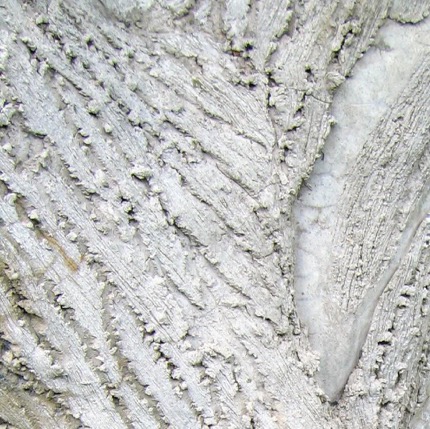
An example of the distinctive bark texture of the original faux bois “master” artisan.
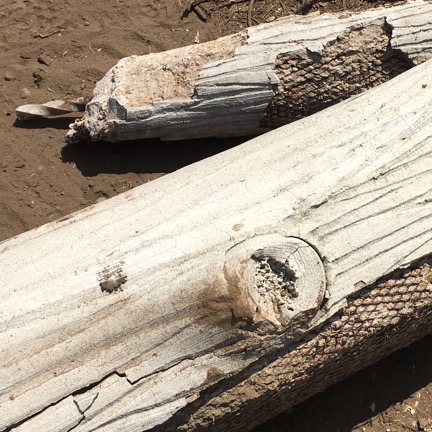
An example of the simplified bark of “the apprentice”.
DH: What type of damage are you repairing and what are the root causes for the structures decay?
TE: The damage is loose concrete as a result of rusting steel inside the structure. When the metal rusts, it expands and pushes away the surrounding material. The root cause of the decay comes from the fact that the mixture of concrete that was originally placed was not fully hydrated. Basically, a stiff “cookie dough” consistency of concrete was used instead of a fluid pour like “pudding”. As a result, the calcium in the cement that was not fully hydrated has been able to move over time as moisture from rain or sprinklers will saturate it and then dry out. If the calcium has filled in the voids around the steel, it prevents it from rusting by wicking the moisture from the steel as it dies out.
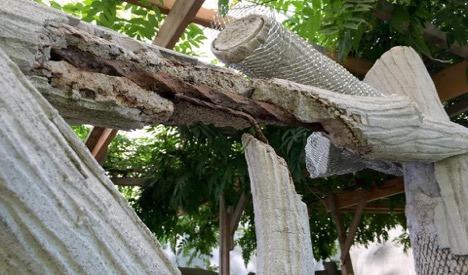
Rusting rebar swells and breaks the surrounding concrete.
DH: While working on this project, you have an intimate knowledge of early concrete construction methods. Have you encountered anything surprising or unexpected?
TE: I found some bits of marble and pieces of old China with a pattern in the original aggregate. Perhaps construction rubble from the mansion provided a source. Also, the rebar is distinctive but not unusual for the time. In fact, the square twisted rod that was used helps me date the work. I am confident it was constructed before other shapes of rebar became common. This rebar shape can be found in the mansion which was built in 1910. My research revealed that this shape was the first patented system of reinforced concrete in America, and was invented in San Francisco in the 1880’s.
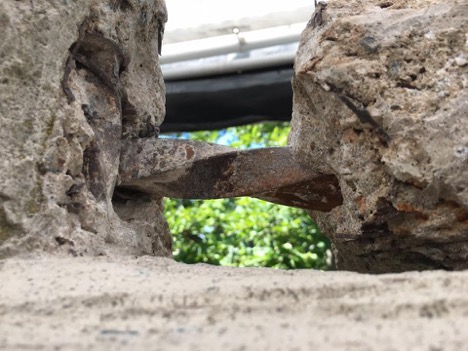
The distinctive square twisted steel rod that was used to build the original structure helped Terry pinpoint the era when it was built.
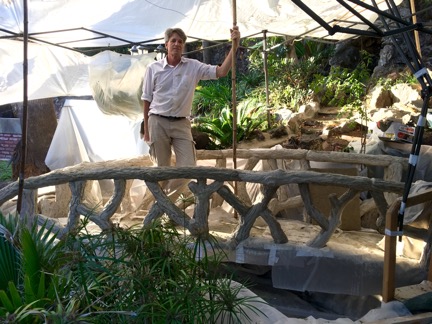
Terry restoring a faux bois bridge.
DH: What was the most daunting faux bois restoration challenge you’ve ever faced?
TE: I had a small bridge over a water feature that needed restoration a few years ago for a private client. Restoration is tough to bid. You prepare yourself (and the client) for the worst case scenario only to discover it’s still more work than you thought it would be. I took on the project for a fixed price. My pride in the craft takes charge and integrity will not allow me to change the price or cut corners once we’ve signed on. They loved the finished product. Predicting the time it takes is not my strength.
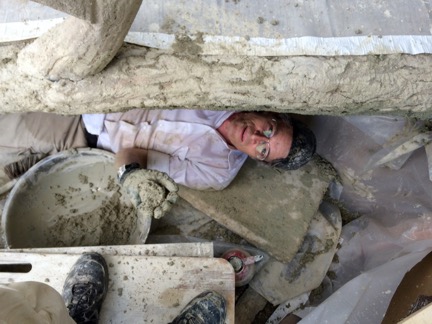
Terry laments: “Sometimes restoration can be more work than you thought it would be.”
DH: Could you describe what a “typical” work day might be like for you?
TE: I don’t like to admit it, but it starts with my distractions…..checking my emails, etc. I pack a lunch. Then I gather supplies I might need before I get to the site. I prefer not leaving the site once I’m there. My best hour is after guests leave at the end of the day, alone with Mr. Huntington’s ghost.
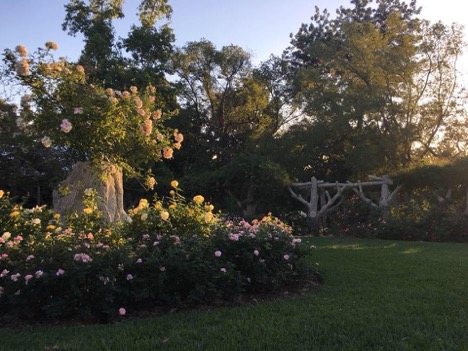
Terry loves the end of the day when the garden is quiet and it’s just him, faux bois trees, and Mr. Huntington’s ghost.
DH: What is the most enjoyable part of your job?
TE: Certainly, the questions from guests that are surprised to learn that this collection of sculptures with vines growing on them are not real trees. The moment of revealing a trompe l’oeil illusion is priceless! The unmasking of the magic trick never gets old.
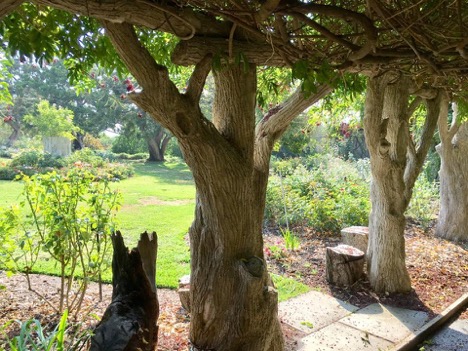
Many visitors are surprised to find that the trees are actually sculptures.
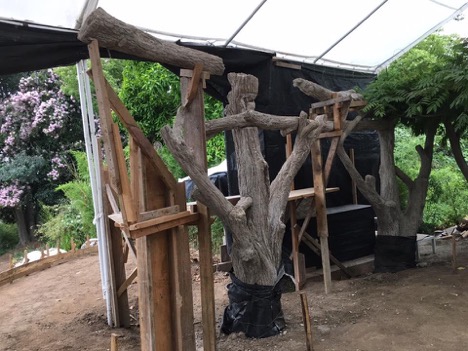
This faux bois tree is being modified to accommodate a change in the grade of the path.
DH: What is it like to be an on-site ambassador for faux bois in addition to actually working on projects all day? Is it difficult to talk and work at the same time?
TE: I think half of my job is storytelling. It can feel like a constant flow of “lectures” only responding to questions. I take them all seriously and answer in depth. I enjoy the talks and my enthusiasm for the craft shows. Fortunately for me, the mission of The Huntington is education.
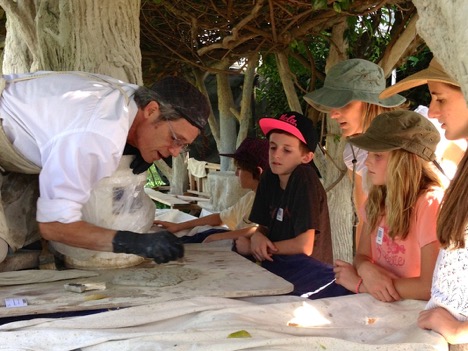
Terry explains faux bois to an enthusiastic audience.
DH: What questions do you get asked the most by visitors?
TE: The most common questions are: “What are you doing?; Are these fake trees?; How deep do they go?; How long does this take?” Slightly less common questions include: “What did you do before this?; What is your background? How did you get this job? Where did you learn this? Are you an artist?”
DH: What is the most unusual question a visitor has ever asked you?
TE: I’d have to say: “Are you coating these dead trees with cement to preserve them? Is there a tree inside?” I guess some people are only able to see what is existing and can’t fathom hand crafting a tree from its beginning.
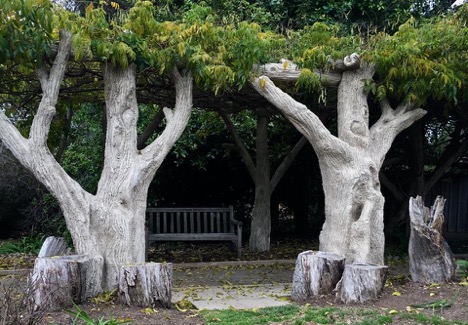
Some visitors wonder if Terry is coating dead trees with cement to preserve them!
DH: What do you most want to impart to the people you talk to each day?
TE: It is a huge privilege for me to restore and enhance this piece of The Huntington legacy. My passion for it is obvious. For guests that want to make something, I offer this advice: Let your passion fuel your tenacity. If you let go too soon you may never find out what it can become.
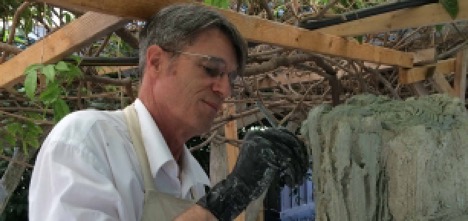
Terry treasures every minute doing what he loves and inspiring others to find their bliss.
Q: How did you first become interested in faux bois?
A: I discovered it as a very small kid, from examples in my neighborhood. We lived on a slope, and I can remember pulling my wagon to the top of the block to get a roll down the sidewalk, and noticing the sidewalk change to “boardwalk” with log curbs, driveways, handrails, stairs, stump planters, concrete mushrooms, benches, water features, etc. that unify a group of eight Bungalows. That’s where I played “hide and seek”. It was all overgrown and I just loved it.
DH: What are your goals as a faux bois artisan?
TE: I’ve already surpassed them. Sharing the project with guests of The Huntington while I work in a makeshift studio? I don’t know how it gets any better than that. New work that is in my future is icing on the cake.

Terry says there’s nowhere he’d rather be than in a makeshift studio explaining faux bois to others.
DH: What would you like your own faux bois legacy to be?
TE: I’ve enlightened the world that reinforced concrete always was and remains a noble craft medium on par with pottery. It’s a bit lofty but I think that was the point of your question. It assumes that I actually have a legacy.
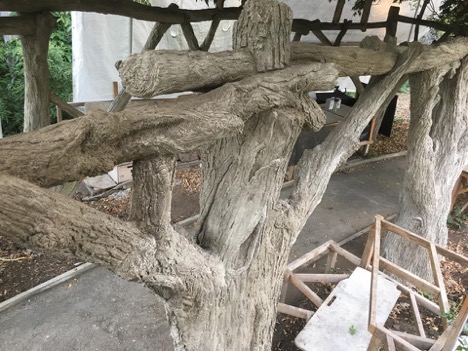
Terry’s faux bois restoration work includes exquisite bark and wood pattern details.
DH: A hundred years from now, what would you like people to know about you through your work?
TE: I did serious work that has whimsy.
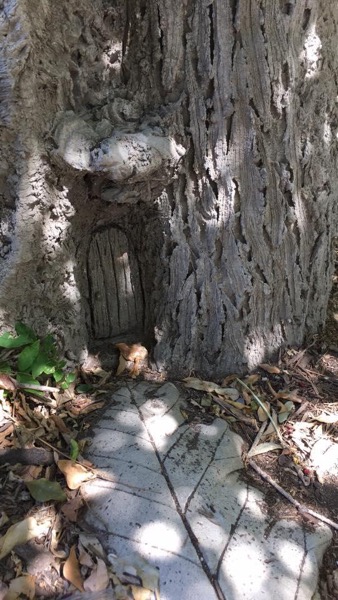
A miniature door adds a whimsical detail to a faux bois tree.
DH: What will you do when this project is done?”
TE: I am nearing completion of the restoration. More than ninety-five trees have been restored. The project has been watched by so many for so long. Right now I’m working on the end of a section that has been getting a lot of attention because I’m altering the structure with all new work.
Many visitors comment that it appears I am getting to “the end”. My usual reply is I am getting to this end, but there are more ends to work on. An initiative for new access to be created for wheelchairs and strollers and the generosity of the patrons to fund it, the end could be quite a bit further down my path.
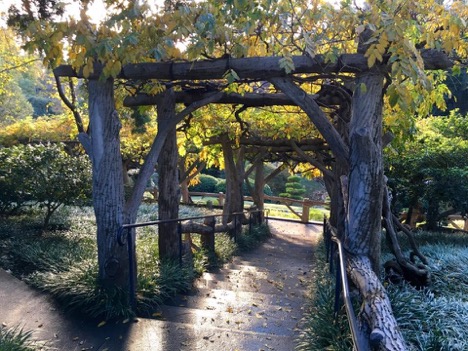
Terry hopes that an end to The Huntington faux bois project is quite a bit further down his path.
All photos were provided by Terry Eagan.
Related Articles:
To learn more about caring for vintage faux bois furniture, see Diane’s blog at: https://fauxboisfurniture.com/faux-bois-bench-care-advice/
To learn more about historical faux bois in America, see Diane’s blog at: https://fauxboisfurniture.com/mccourtie-park-faux-bois-bridges/
Diane Husson is a concrete sculptor specializing in the design and creation of contemporary faux bois benches and other faux bois furniture and accessories. She lives in Norfolk, Virginia. If you are interested in finding out more about her work you may contact her at dianehusson@cox.net
Visit Diane’s faux bois website at https://www.fauxboisfurniture.com
